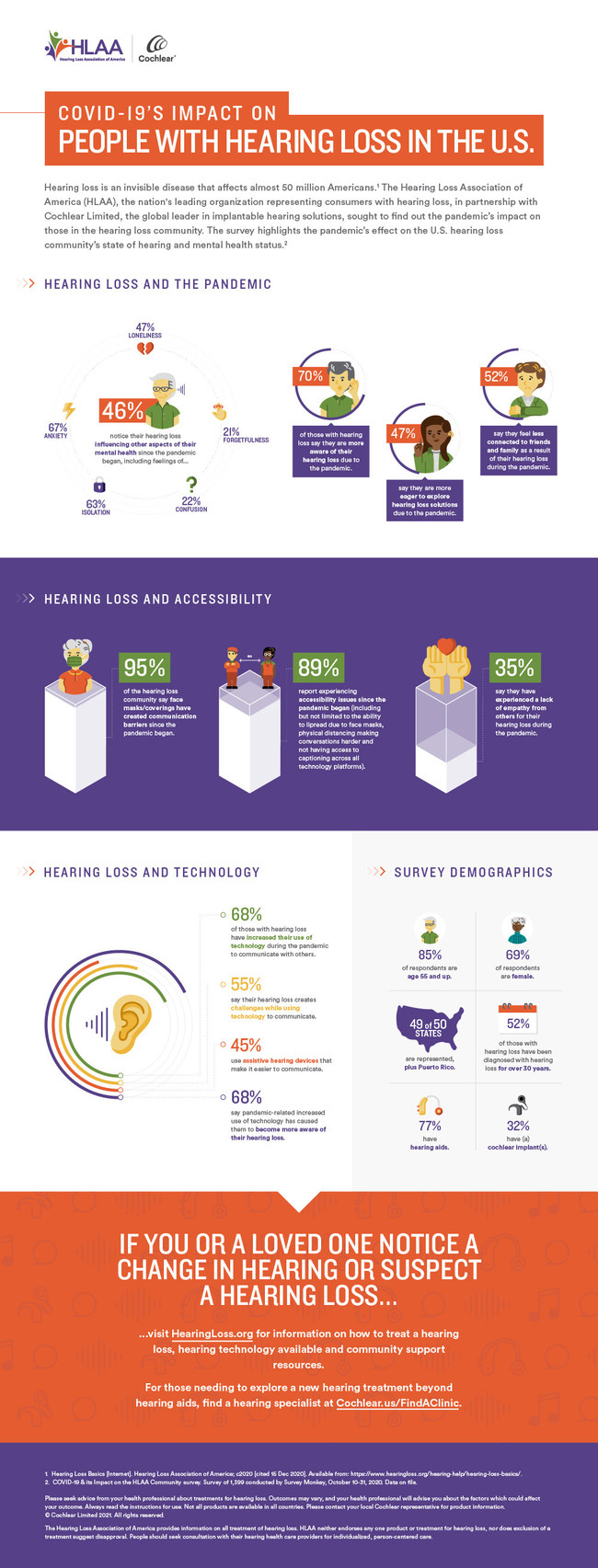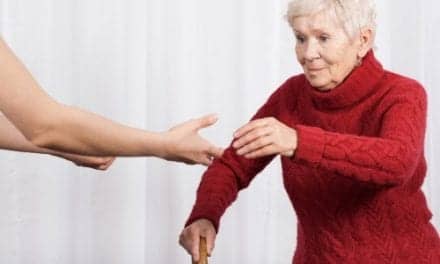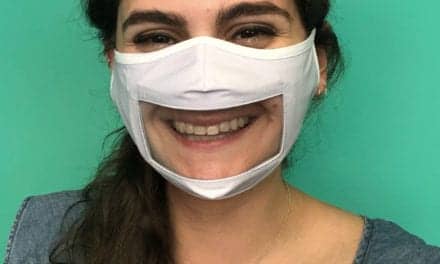Ninety-five percent of people living with hearing loss in the United States say masks and facial coverings impact their ability to communicate during the COVID-19 pandemic, which has also heightened levels of anxiety, social isolation, and other mental health-related effects among nearly half of the nation’s hearing loss community.1

This is according to a new survey conducted by the Hearing Loss Association of America (HLAA), an organization representing consumers with hearing loss, in partnership with Cochlear Limited, a company specializing in implantable hearing solutions. HLAA and Cochlear jointly announced the results of the survey here.
Related article: NAL Update: Impact of Face Masks and Face Shields on Communication
Hearing loss is an invisible disease that affects almost 50 million Americans.2 The online survey of 1,399 participants sought to find out the pandemic’s impact on those in the hearing loss community, including individuals with hearing loss, their loved ones and their hearing health care professionals. Key findings include:
Hearing Loss and the Pandemic
- 70% of those with hearing loss say they are more aware of their hearing loss due to the pandemic, and 47% say they are more eager to explore hearing loss solutions due to the pandemic.
- 46% notice their hearing loss influencing other aspects of their mental health since the pandemic began, with:
- 67% having feelings of anxiety
- 63% having feelings of isolation
- 47% having feelings of loneliness
- 22% having feelings of confusion
- 21% having feelings of forgetfulness
- 52% say they feel less connected to friends and family as a result of their hearing loss during the pandemic.
Hearing Loss and Accessibility
- 95% of the hearing loss community say face masks/coverings have created communication barriers since the pandemic began.
- 89% report experiencing accessibility issues since the pandemic began (including but not limited to the ability to lipread due to face masks, physical distancing making conversations harder, and not having access to captioning across all technology platforms).
- 35% say they have experienced a lack of empathy from others for their hearing loss during the pandemic.
“Hearing and understanding are two different things. With masks, I can hear you, but I don’t always understand you,” said Lori A. Mertes, NBCT, MEd, MAT, special education teacher and bimodal hearing recipient (a cochlear implant in one ear, and a hearing aid in the other). “Given that we all may be challenged to hear with masks right now, I hope others will understand the challenges many of us in the hearing loss community face on a regular basis and now have amplified because of masks and distancing. Please slow down, speak clearly, be patient with us, and if we ask to you to repeat, please don’t say, ‘never mind.’ It’s very frustrating to be dismissed.”
Hearing Loss and Technology
- 68% of those with hearing loss have increased their use of technology during the pandemic to communicate with others.
- 68% say pandemic-related increased use of technology has caused them to become more aware of their hearing loss.
- 55% say their hearing loss creates challenges while using technology to communicate, while 45% use assistive hearing devices that make it easier to communicate.
“With the prolonged pandemic, I did not realize the mental stress and fatigue culminated over time would add to the challenges to understand with masks,” said Tim Browning, digital communication and web specialist, HLAA, and bilateral hearing aid user (a hearing aid in each ear). “I am missing the day-to-day practice of listening and talking to people in face-to-face situations. Online communications and captioning are wonderful, but to effectively hear requires continual practice hearing in all situations. When we get out of practice, it becomes harder and harder to understand with masks, so we then have to advocate for ourselves all that much more.”
“Research has long shown untreated hearing loss can negatively impact a person’s quality of life – and with masks and distancing, the impact the pandemic has had on people with hearing loss is enormous,” said Barbara Kelley, Executive Director, HLAA. “The survey results reinforce the overwhelming challenge with masks for the hearing loss community, and many requested that the larger population invest in safe, clear face masks. Additionally, the hearing loss community would like to see universal captioning provided across all technology platforms. I hope coming out of this pandemic we will see people continue to take their hearing loss seriously and treat it appropriately, as well as continue to see greater standards on accessibility to help those with hearing loss.”
Hearing Loss and Hearing Health Care
- 87% of hearing health care providers say they have seen increased signs of loneliness or isolation in their patients since the pandemic began.*
- 84% of hearing health care providers say they have noticed an increase in their patients’ awareness of their hearing loss during the pandemic, and 52% say they have seen an increase in their patients’ desire to explore new hearing loss solutions due to the pandemic.*
- 51% of those with hearing loss report their hearing health care provider offers remote care options, and 36% say they have used, or have thought of using, remote care options during the pandemic.
“Many individuals with hearing loss and their loved ones are now realizing how important hearing and connection is to our overall quality of life. While the pandemic has challenged our ability to hear and connect, this realization is empowering consumers to act and seek treatment for their hearing loss,” said Patricia Trautwein, MA, AuD, Vice President, Product Management & Marketing, Cochlear Americas. “We hope, given the results of this survey, individuals, health care professionals, and payors will focus on prioritizing hearing health and begin setting standards around protecting our hearing, monitoring hearing loss, and ensuring individuals have access to and can obtain appropriate treatment for their hearing loss.”
In the United States, one out of three people over the age of 65 and half of people over 75 are affected by disabling hearing loss, 3 but appropriate hearing treatment and technology continues to be widely underutilized.4 Research continues to show aging adults with untreated hearing loss can be substantially affected by social isolation and loneliness with impacts to brain health and quality of life.5
References
- COVID-19 & its Impact on the HLAA Community survey. Survey of 1,399 conducted by Survey Monkey, October 10-31, 2020. Data on file.
- Hearing Loss Association of America (HLAA) website. Hearing Loss Basics. https://www.hearingloss.org/hearing-help/hearing-loss-basics/. Accessed December 15, 2020.
- National Institute on Deafness and Other Communication Disorders (NIDCD) website. Hearing Loss & Older Adults. https://www.nidcd.nih.gov/health/hearing-loss-older-adults. Accessed November 26, 2020. Published July 17, 2018.
- Market penetration. This figure is a global estimate based on Cochlear sourced data.
- Brody JE. Hearing loss threatens mind, life and limb. New York Times. https://www.nytimes.com/2018/12/31/well/live/hearing-loss-threatens-mind-life-and-limb.html. Published December 31, 2018.
* Not statistically significant given 44 respondents (3%) identified as a hearing health care professional.
Source: HLAA, Cochlear
Image: HLAA, Cochlear





